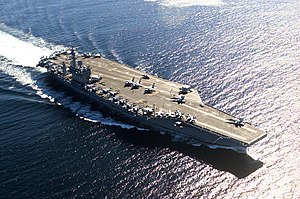
Power projection
Capacity of a state to deploy and sustain military forces outside its territory / From Wikipedia, the free encyclopedia
Dear Wikiwand AI, let's keep it short by simply answering these key questions:
Can you list the top facts and stats about Power projection?
Summarize this article for a 10 years old
Power projection (or force projection or strength projection) in international relations is the capacity of a state to deploy and sustain forces outside its territory.[1] The ability of a state to project its power into an area may serve as an effective diplomatic lever, influencing the decision-making processes and acting as a potential deterrent on other states' behavior.[2][3][4][5]

| Part of a series on |
| War |
|---|
|
This ability is a crucial element of a state's power in international relations. Any state able to direct its military forces outside its territory might be said to have some level of power projection capability, but the term itself is used most frequently in reference to militaries with a worldwide reach (or at least significantly broader than a state's immediate area). Even states with sizable hard power assets (such as a large standing army) may only be able to exert limited regional influence so long as they lack the means of effectively projecting their power on a global scale. Generally, only a select few states are able to overcome the logistical difficulties inherent in the deployment and direction of a modern, mechanized military force.[6][7] Allies and partners can take up or share some of the burden of power projection.[8][9][10] One measure of the capability of a state to project power is loss of Strength Gradient, until a culminating point is apparent to others, once an operation is underway.
A state might § compete in the gray zone just short of conflict, exercising its soft power, or hard power, in a bid for potential superpower.[11][12]: 1:47 [lower-alpha 1] While traditional measures of power projection typically focus on hard power assets (tanks, soldiers, aircraft, naval vessels, etc.), the use of soft power shows that power projection does not necessarily have to actively put military forces in combat, but only potentially.[13] Assets for power projection can often serve dual uses, as the deployment of various countries' militaries during the humanitarian response to the 2004 Indian Ocean earthquake illustrates.